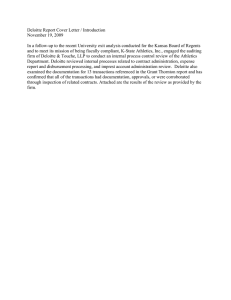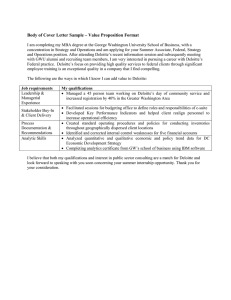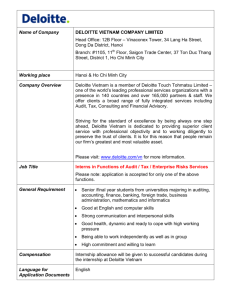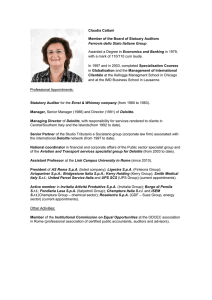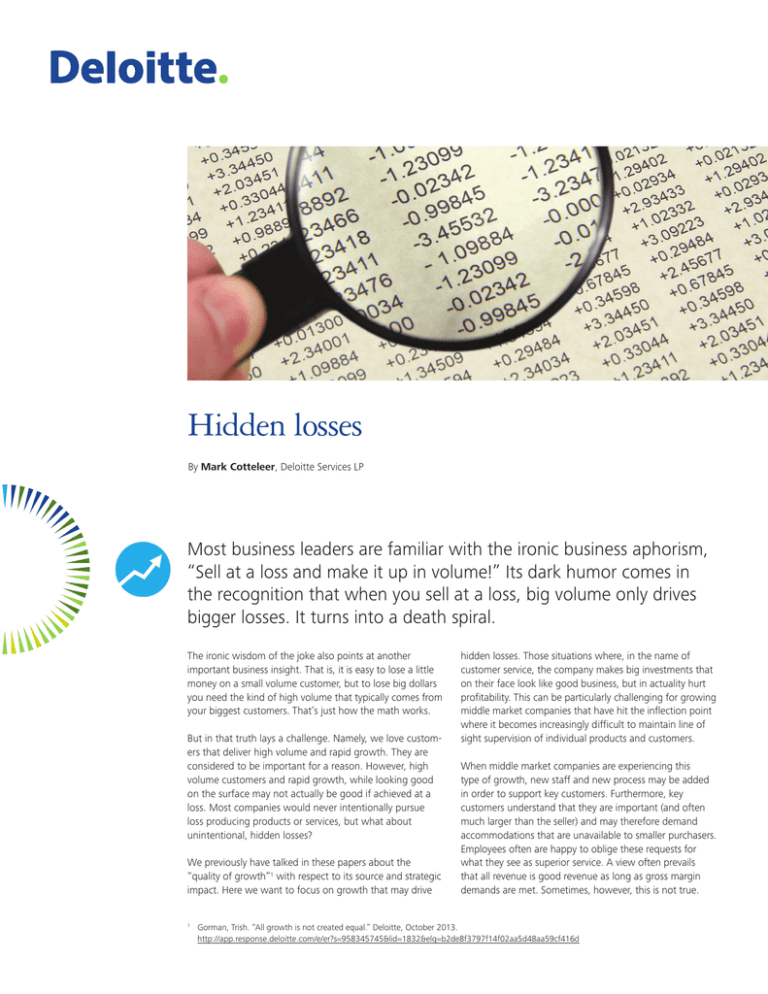
Hidden losses
By Mark Cotteleer, Deloitte Services LP
Most business leaders are familiar with the ironic business aphorism,
“Sell at a loss and make it up in volume!” Its dark humor comes in
the recognition that when you sell at a loss, big volume only drives
bigger losses. It turns into a death spiral.
The ironic wisdom of the joke also points at another
important business insight. That is, it is easy to lose a little
money on a small volume customer, but to lose big dollars
you need the kind of high volume that typically comes from
your biggest customers. That’s just how the math works.
But in that truth lays a challenge. Namely, we love customers that deliver high volume and rapid growth. They are
considered to be important for a reason. However, high
volume customers and rapid growth, while looking good
on the surface may not actually be good if achieved at a
loss. Most companies would never intentionally pursue
loss producing products or services, but what about
unintentional, hidden losses?
We previously have talked in these papers about the
“quality of growth”1 with respect to its source and strategic
impact. Here we want to focus on growth that may drive
1
hidden losses. Those situations where, in the name of
customer service, the company makes big investments that
on their face look like good business, but in actuality hurt
profitability. This can be particularly challenging for growing
middle market companies that have hit the inflection point
where it becomes increasingly difficult to maintain line of
sight supervision of individual products and customers.
When middle market companies are experiencing this
type of growth, new staff and new process may be added
in order to support key customers. Furthermore, key
customers understand that they are important (and often
much larger than the seller) and may therefore demand
accommodations that are unavailable to smaller purchasers.
Employees often are happy to oblige these requests for
what they see as superior service. A view often prevails
that all revenue is good revenue as long as gross margin
demands are met. Sometimes, however, this is not true.
Gorman, Trish. “All growth is not created equal.” Deloitte, October 2013.
http://app.response.deloitte.com/e/er?s=958345745&lid=1832&elq=b2de8f3797f14f02aa5d48aa59cf416d
Drivers of hidden losses exist where costs are generated,
but not directly linked to the customer being served. If
a business has high SGA and other expenses “below the
gross margin line,” then it is a good bet that such losses
exist, but are unrecognized. In an effort to grow the
customer — to attain that next big contract or order —
the company may acquiesce to providing services that if
left untended can turn into drivers of hidden loss. These
might include:
1. Small, high frequency orders or frequent low volume
deliveries
2. Frequent order changes or returns
3. High levels of customization
4. Late payment or demands for extended payment terms
5. Significant demands for pre- and post-sales support
6. Expedited requests
The challenge growing mid-market companies face is
that drivers of hidden loss often look a lot like drivers of
superior service. In fact, they can be both at once. Here
we argue not against providing service, but rather in favor
of understanding how these costs accumulate against
and mitigate the profitability of the business — so the
investment can be wisely made. A few critical steps ought
to help:
2. When staff and other resources are added to support
the business, document their intended link to customers
within the profitability statement — even if the expense
is considered “fixed” or “general.” Try to avoid falling
into the trap of believing all customers consume
company resources evenly. Except for a subset of truly
central services, this likely is untrue.
3. Be honest with yourself. Companies often find that
those they think are their “best” customers turn out to
be drags on profitability. If this ends up being the case,
don’t overreact. There are plenty of ways to make an
unprofitable customer profitable. Knowing, as they say,
is half the battle.
You might quickly find that you see reason to pursue a
more accurate Activity Based Costing project to understand
not just customer, but product and service line profitability
as well. The keys to success in such an endeavor are to
focus on the big picture (as opposed to bogging down
in the minutia), link cost and customers (or products,
etc.) in ways that are relatively easy to understand and
communicate, and develop a system that is practical, and
easy to execute and maintain. By tending to these simple
practices, executives can continue on their thoughtful path
to quality growth.
Mark Cotteleer is a director with Deloitte Services LP and
the theme leader for performance eminence. Contact him
by phone at (414) 977-2359 or by email at mcotteleer@
deloitte.com.
u
1. Consider developing (at least high level) profitability
statements for each customer, especially the biggest,
most important ones.
Perspectives
This white paper is just one example of Deloitte research on topics of interest to mid-market private companies. Presented by
Deloitte Growth Enterprise Services, Perspectives is a multifaceted program that utilizes live events, signature reports, research
publications, webcasts, and other vehicles to deliver tailored and relevant insights in an integrated fashion.
Please visit our Perspectives library on the Deloitte Growth Enterprise Services website
(http://www.deloitte.com/us/perspectives/dges) to view additional material on issues facing mid-market private companies.
This publication contains general information only and Deloitte is not, by means of this publication,
rendering accounting, business, financial, investment, legal, tax, or other professional advice or services.
This publication is not a substitute for such professional advice or services, nor should it be used as a
basis for any decision or action that may affect your business. Before making any decision or taking any
action that may affect your business, you should consult a qualified professional advisor. Deloitte shall
not be responsible for any loss sustained by any person who relies on this publication.
As used in this document, "Deloitte" means Deloitte LLP and its subsidiaries. Please see www.deloitte.
com/us/about for a detailed description of the legal structure of Deloitte LLP and its subsidiaries. Certain
services may not be available to attest clients under the rules and regulations of public accounting.
Copyright © 2014 Deloitte Development LLC. All rights reserved.
Member of Deloitte Touche Tohmatsu Limited


